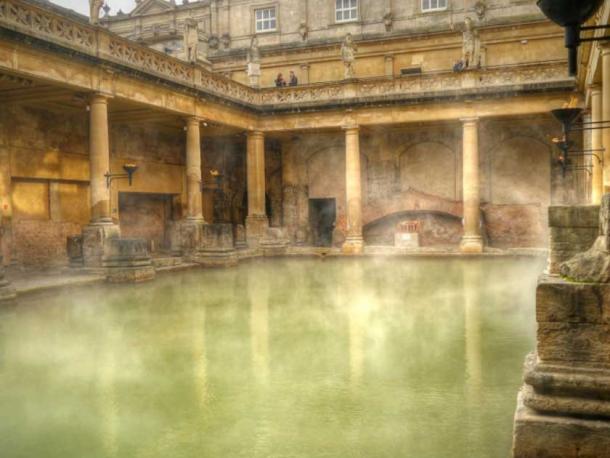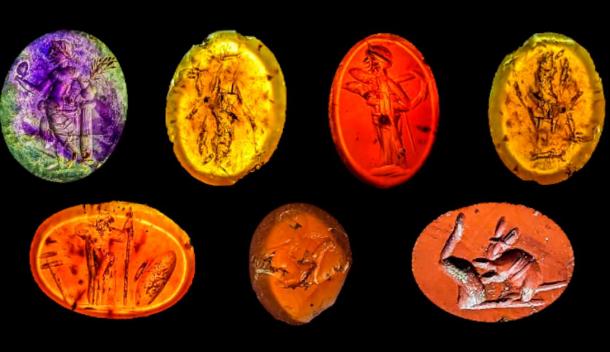Two thousand years ago, beautifully carved Roman stones taken into an ancient pool were lost by the bathers. Now they have been recovered during archaeological excavations in Carlisle, adjacent to Hadrian’s Wall. As many as 30 semi-precious stones that had dropped out of their ring settings, their glue weakened by the steamy baths, have been rediscovered at the site, and described as an “incredible” discovery by archaeologists.
Intaglios: Craftsmanship of the Highest Order
‘Intaglios’, as the engraved gems are called, were prized for their high quality of craftsmanship, as evidenced by their expertly carved images that measure just a few millimeters in diameter. Dating back to the late 2nd to early 3rd century, this collection features a rare amethyst depicting Venus holding either a flower or a mirror.
Another gemstone, a beautifully crafted red-brown jasper, depicts a satyr seated on rocks beside a sacred column. These gems were highly valuable during their time, reports The Guardian . They were likely flushed into the drains when the pools and saunas got cleaned.
“It’s incredible… It’s caught everyone’s imagination. They were just falling out of people’s rings who were using the baths. They were set with a vegetable glue and, in the hot and sweaty bathhouse, they fell out of the ring settings,” said Frank Giecco, an expert on Roman Britain who is leading the bathhouse excavation.

The Great Bath, at Roman baths at Bath, England is a pool with hot, steaming spa water. (David Dixon / CC BY-SA 2.0 )
Along with the intaglios, 40 women’s hairpins, 35 glass beads, a clay Venus figure, animal bones, and imperial-stamped tiles were also discovered. This suggested that the Roman elite lived near Hadrian’s Wall and the fort of Lugavalium, a short distance away from Carlisle Castle . Hadrian’s Wall served as the northern frontier of the empire, holding an elite cavalry unit, and links to the imperial court.
The bath house is located near the Roman fort of Uxelodunum, also known as Petriana, in modern-day Stanwix, Carlisle. Uxelodunum, meaning “high fort,” was built to control the western territories near present-day Carlisle and the strategic River Eden crossing.

A selection of the intaglios found at the Carlisle Cricket Club site. (Anna Giecco/ Wardell Armstrong )
Uncovering Roman Carlisle: An Exercise in Intricate Excavations
The finds are part of the Uncovering Roman Carlisle project, underway since 2017 after the discovery of a 3rd century Roman bathhouse. The team has been conducting a community supported excavation at the Carlisle Cricket Club, supported by archaeologists from Wardell Armstrong.
Giecco further explained that gems like these intaglios were never found at Roman sites associated with people from a lower-status. Unlikely to be worn by the poor, the intaglios are miniscule, some at 5 mm, with 16 mm the largest. The very act of engraving on such a small surface suggests a level of craftsmanship far ahead of its time.
“Metal expands. If the stone is not properly secured, it can fall out, as it can today with people bathing. I imagine that the gems recovered from the drain were accumulated over time, and we must remember that a lot of people used those baths.”
Previous excavations at the bath house have uncovered several rooms, including a hypocaust system, intact floors, painted tiles, and terracotta water pipes, as well as fragments of cooking pots. The bath house served as a recreational and bathing area for soldiers, including high-ranking military officials and Roman elites. The intaglios were lost in the heated waters during their visits and then flushed into the drains during cleaning, reports Heritage Daily .
While excavations are slated to continue into the next year, what can be gleaned so far is a monumental and opulent bathhouse complex, which paints a picture of the lives of the Roman elite , in the empire’s heyday.
Top image: Three of the Roman intaglios, engraved semi-precious stones discovered by archaeologists near Hadrian’s Wall. Source: Anna Giecco// Wardell Armstrong
By Sahir Pandey
Source: ancient-origins.net








